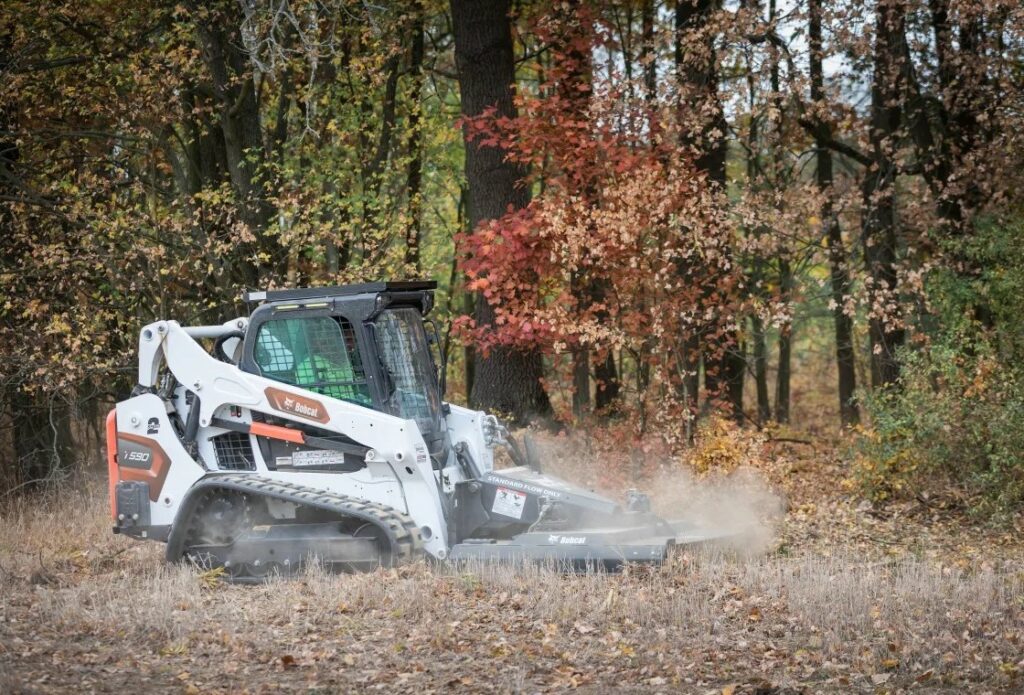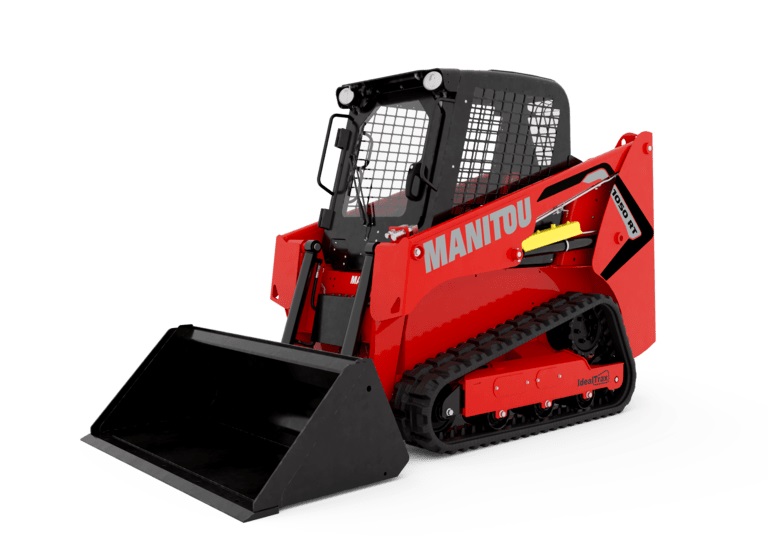A compact track loader is a specialised construction equipment with tracks instead of wheels. These machines seamlessly transition between various tasks essential to construction projects, from digging to hauling materials, eliminating the need for multiple specialised equipment. Equipped with tracks that provide superior traction and stability, compact track loaders can traverse rough, uneven, or muddy surfaces without compromising performance, ensuring continuous operation even in the most challenging conditions. Their compact size and agile steering make them exceptionally manoeuvrable, particularly in confined spaces and crowded job sites, allowing them to access hard-to-reach areas with ease and maximise efficiency and productivity.
Where are compact track loaders used?
Compact track loaders are used across various construction applications.
- Excavation and Digging: Used for digging trenches, foundations, and utility lines.
- Material Handling: Essential for loading trucks, moving materials, and transporting heavy objects.
- Site Preparation: Clearing debris, grading surfaces, and leveling terrain for construction projects.
- Demolition: Removing debris, dismantling structures, and clearing demolition sites.
- Utility Installation: Excavating trenches and installing pipelines, cables, and drainage systems.
- Landscaping and Grading: Spreading mulch, moving rocks and soil, and shaping landscapes.
- Road Construction: Backfilling, compacting, and preparing surfaces for paving in road construction projects.
- Concrete Work: Transporting and pouring concrete, handling formwork, and assisting in concrete-related tasks on construction sites.
Components of a compact track loader;
- Chassis: Provides structural support and houses various components.
- Tracks: Offer superior traction and stability on rough terrain.
- Engine: Powers the loader and its hydraulic system, typically diesel-powered.
- Hydraulic System: Powers functions like lifting, tilting, and attachment operation.
- Loader Arms: Extend forward from the chassis to support attachments.
- Operator’s Cabin: Contains controls and seating for the operator.
- Attachments: Interchangeable tools like buckets, forks, and grapples for various tasks.
Advantages of a compact track loader;
- Superior traction and stability on rough terrain due to tracks.
- Maneuverability in confined spaces and tight job sites.
- Versatility to perform multiple tasks with various attachments.
- Reduced ground pressure, minimizing soil compaction and surface damage.
- Increased efficiency due to faster travel speeds and quick attachment changes.
- Improved flotation over soft ground, reducing the risk of getting stuck.
- Ability to climb steeper inclines than wheeled loaders.
- Quieter operation, which can be advantageous in noise-sensitive areas.
- Better weight distribution, providing more stability when lifting heavy loads.
- Greater efficiency in material handling and loading due to improved stability.
- Compatibility with a wide range of attachments, expanding their versatility.
Types of compact track loaders
Mini Compact Track Loaders:
Mini compact track loaders are characterized by their compact size and maneuverability, making them well-suited for navigating tight spaces and confined job sites. These loaders typically feature a smaller footprint and lower operating weight compared to larger models, allowing them to access areas where larger machinery cannot reach. Despite their size, mini compact track loaders boast impressive performance capabilities, with powerful engines and robust hydraulic systems that enable them to handle a variety of tasks efficiently. They often come equipped with a range of attachments, including buckets, forks, augers, and trenchers, enhancing their versatility for landscaping, residential construction, and indoor projects. Additionally, their lightweight design minimizes ground disturbance, making them suitable for working on sensitive surfaces like lawns and gardens without causing damage.

Large Frame Compact Track Loaders:
Large frame compact track loaders are designed to tackle heavy-duty tasks that require higher lifting capacities and increased stability. These loaders feature a larger chassis and a more powerful engine compared to standard compact track loaders, providing enhanced performance and productivity on demanding job sites. They are equipped with advanced hydraulic systems capable of handling heavy loads and tough terrain with ease. Additionally, large frame compact track loaders often feature spacious and ergonomic operator cabins, complete with comfortable seating, intuitive controls, and excellent visibility, ensuring operator comfort and efficiency during long hours of operation. These loaders are commonly used in commercial construction, road building, and land clearing projects where durability, reliability, and performance are essential.

High Flow Compact Track Loaders:
High flow compact track loaders are distinguished by their high-flow hydraulic systems, which provide increased hydraulic power for operating high-performance attachments. These loaders are designed to handle demanding tasks such as forestry mulching, brush cutting, and demolition with maximum efficiency and productivity. They feature powerful engines and heavy-duty components to withstand the rigors of continuous heavy-duty use. High flow compact track loaders offer versatility, allowing operators to quickly and easily switch between a variety of attachments to suit the needs of the job. With their enhanced hydraulic capabilities, these loaders excel in applications where increased hydraulic flow is necessary for optimal attachment performance, making them indispensable tools for contractors and operators in various industries.

Compact Track Loaders with Telescopic Booms:
Compact track loaders with telescopic booms combine the versatility of a compact track loader with the extended reach of a telescopic boom attachment. These loaders feature a telescopic boom that extends and retracts, providing increased reach and height capabilities for accessing elevated work areas and reaching over obstacles. They are versatile machines suitable for a wide range of applications, including loading trucks, placing materials at height, and working in confined spaces where traditional loaders may not have sufficient reach. Compact track loaders with telescopic booms typically offer excellent stability and lifting performance, allowing operators to handle heavy loads with precision and confidence. With their telescopic boom attachment, these loaders are valuable assets for construction, roofing, and agricultural operations where versatility and reach are essential for completing tasks efficiently and safely.

Conclusion
Compact track loaders stand as indispensable assets in the realm of construction, offering a harmonious blend of versatility, maneuverability, and efficiency. From excavation and material handling to site preparation and utility installation, these machines prove their worth across a wide spectrum of construction tasks. With their robust construction, advanced features, and ergonomic design, compact track loaders continue to play a pivotal role in shaping the landscape of modern construction, contributing to safer, more efficient, and more sustainable building practices. As the construction industry evolves, compact track loaders remain steadfast, poised to meet the demands of ever-changing job site challenges with unwavering reliability and performance.
Image Source: bobcat.com, gainwellindia.com, manitou.com/en-IN/

